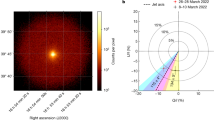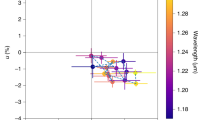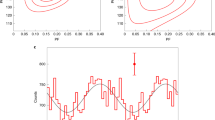Abstract
The centre of the Milky Way Galaxy hosts a black hole with a solar mass of about 4 million (Sagittarius A* (Sgr A)) that is very quiescent at present with a luminosity many orders of magnitude below those of active galactic nuclei1. Reflection of X-rays from Sgr A* by dense gas in the Galactic Centre region offers a means to study its past flaring activity on timescales of hundreds and thousands of years2. The shape of the X-ray continuum and the strong fluorescent iron line observed from giant molecular clouds in the vicinity of Sgr A* are consistent with the reflection scenario3,4,5. If this interpretation is correct, the reflected continuum emission should be polarized6. Here we report observations of polarized X-ray emission in the direction of the molecular clouds in the Galactic Centre using the Imaging X-ray Polarimetry Explorer. We measure a polarization degree of 31% ± 11%, and a polarization angle of −48° ± 11°. The polarization angle is consistent with Sgr A* being the primary source of the emission, and the polarization degree implies that some 200 years ago, the X-ray luminosity of Sgr A* was briefly comparable to that of a Seyfert galaxy.
This is a preview of subscription content, access via your institution
Access options
Access Nature and 54 other Nature Portfolio journals
Get Nature+, our best-value online-access subscription
$29.99 / 30 days
cancel any time
Subscribe to this journal
Receive 51 print issues and online access
$199.00 per year
only $3.90 per issue
Buy this article
- Purchase on Springer Link
- Instant access to full article PDF
Prices may be subject to local taxes which are calculated during checkout




Similar content being viewed by others
Data availability
The IXPE data that support the findings of this study are freely available in the HEASARC IXPE data archive (https://heasarc.gsfc.nasa.gov/docs/ixpe/archive/). The XMM-Newton data can be found on the same website, and the Chandra data will be public after one year from the observation date.
Code availability
The analysis and simulation software ixpeobssim developed by the IXPE collaboration and its documentation are available publicly through https://ixpeobssim.readthedocs.io/en/latest/?badge=latest.494. XSPEC is distributed and maintained under the aegis of the HEASARC and can be downloaded as part of HEAsoft from http://heasarc.gsfc.nasa.gov/docs/software/lheasoft/download.html.
References
Genzel, R., Eisenhauer, F. & Gillessen, S. The Galactic Center massive black hole and nuclear star cluster. Rev. Mod. Phys. 82, 3121–3195 (2010).
Vainshtein, L. A. & Syunyaev, R. A. The K-alpha lines in the background X-ray spectrum and the interstellar gas in galaxies. Sov. Astron. Lett. 6, 353–356 (1980).
Sunyaev, R. A., Markevitch, M. & Pavlinsky, M. The center of the Galaxy in the recent past: a view from GRANAT. Astrophys. J. 407, 606 (1993).
Markevitch, M., Sunyaev, R. A. & Pavlinsky, M. Two sources of diffuse X-ray emission from the Galactic Centre. Nature 364, 40–42 (1993).
Koyama, K. et al. ASCA view of our Galactic Center: remains of past activities in X-rays? Publ. Astron. Soc. Jpn 48, 249–255 (1996).
Churazov, E., Sunyaev, R. & Sazonov, S. Polarization of X-ray emission from the Sgr B2 cloud. Mon. Not. R. Astron. Soc. 330, 817–820 (2002).
Khabibullin, I., Churazov, E. & Sunyaev, R. SRG/eROSITA view of X-ray reflection in the Central Molecular Zone: a snapshot in September-October 2019. Mon. Not. R. Astron. Soc. 509, 6068–6076 (2022).
Revnivtsev, M. et al. Discrete sources as the origin of the Galactic X-ray ridge emission. Nature 458, 1142–1144 (2009).
Di Gesu, L. et al. Prospects for IXPE and eXTP polarimetric archaeology of the reflection nebulae in the Galactic center. Astron. Astrophys. 643, A52 (2020).
Ferrazzoli, R. et al. Prospects for a polarimetric mapping of the Sgr A molecular cloud complex with IXPE. Astron. Astrophys. 655, A108 (2021).
Wang, Q. D., Lu, F. & Lang, C. C. X-ray thread G0.13-0.11: a pulsar wind nebula? Astrophys. J. 581, 1148–1153 (2002).
Churazov, E., Khabibullin, I., Ponti, G. & Sunyaev, R. Polarization and long-term variability of Sgr A* X-ray echo. Mon. Not. R. Astron. Soc. 468, 165–179 (2017).
Marin, F., Muleri, F., Soffitta, P., Karas, V. & Kunneriath, D. Reflection nebulae in the Galactic center: soft X-ray imaging polarimetry. Astron. Astrophys. 576, A19 (2015).
Kislat, F., Clark, B., Beilicke, M. & Krawczynski, H. Analyzing the data from X-ray polarimeters with Stokes parameters. Astropart. Phys. 68, 45–51 (2015).
Khabibullin, I., Churazov, E. & Sunyaev, R. Impact of intrinsic polarization of Sgr A* historical flares on (polarization) properties of their X-ray echoes. Mon. Not. R. Astron. Soc. 498, 4379–4385 (2020).
Sunyaev, R. & Churazov, E. Equivalent width, shape and proper motion of the iron fluorescent line emission from molecular clouds as an indicator of the illuminating source X-ray flux history. Mon. Not. R. Astron. Soc. 297, 1279–1291 (1998).
Yamauchi, S., Maeda, Y. & Koyama, K. ASCA observation of the Galactic Center. Adv. Space Res. 19, 63–70 (1997).
Ryu, S. G., Koyama, K., Nobukawa, M., Fukuoka, R. & Tsuru, T. G. An X-ray face-on view of the Sagittarius B molecular clouds observed with Suzaku. Publ. Astron. Soc. Jpn 61, 751 (2009).
Ryu, S. G. et al. X-ray echo from the Sagittarius C complex and 500-year activity history of Sagittarius A*. Publ. Astron. Soc. Jpn 65, 33 (2013).
Terrier, R. et al. Fading hard X-ray emission from the Galactic Center molecular cloud Sgr B2. Astrophys. J. 719, 143–150 (2010).
Chuard, D. et al. Glimpses of the past activity of Sgr A* inferred from X-ray echoes in Sgr C. Astron. Astrophys. 610, A34 (2018).
Churazov, E., Khabibullin, I., Sunyaev, R. & Ponti, G. Can Sgr A* flares reveal the molecular gas density PDF? Mon. Not. R. Astron. Soc. 471, 3293–3304 (2017).
Ptak, A. in X-ray Astronomy: Stellar Endpoints, AGN, and the Diffuse X-ray Background Vol. 599 (eds White, N. E. et al.), 326–335 (American Institute of Physics, 2001).
Halderson, E. L., Moran, E. C., Filippenko, A. V. & Ho, L. C. The soft X-ray properties of nearby low-luminosity active galactic nuclei and their contribution to the cosmic X-ray background. Astron. J. 122, 637–652 (2001).
Soderberg, A. et al. in astro2010: The Astronomy and Astrophysics Decadal Survey Vol. 2010 (NASA, 2009).
Weisskopf, M. C. et al. The Imaging X-Ray Polarimetry Explorer (IXPE): pre-launch. J. Astron. Telesc. Instrum. Syst. 8, 026002 (2022).
Ferrazzoli, R. et al. In-flight calibration system of Imaging X-ray Polarimetry Explorer. J. Astron. Telesc. Instrum. Syst. 6, 048002 (2020).
Rankin, J. et al. An algorithm to calibrate and correct the response to unpolarized radiation of the X-ray polarimeter onboard IXPE. Astron. J. 163, 39 (2022).
Baldini, L. et al. ixpeobssim: a simulation and analysis framework for the imaging X-ray polarimetry explorer. SoftwareX 19, 101194 (2022).
Muleri, F. et al. in Space Telescopes and Instrumentation 2016: Ultraviolet to Gamma Ray Vol. 9905 (eds den Herder, J.-W. A. et al.) 99054G (Society of Photo-Optical Instrumentation Engineers, 2016).
Vikhlinin, A. et al. Chandra Cluster Cosmology Project. II Samples and X-ray data reduction. Astrophys. J. 692, 1033–1059 (2009).
Yuasa, T., Makishima, K. & Nakazawa, K. Broadband spectral analysis of the Galactic Ridge X-ray emission. Astrophys. J. 753, 129 (2012).
Marin, F., Karas, V., Kunneriath, D. & Muleri, F. Prospects of 3D mapping of the Galactic Centre clouds with X-ray polarimetry. Mon. Not. R. Astron. Soc. 441, 3170–3176 (2014).
Kapteyn, J. C. On the motion of Nebulae in vicinity of Nova Persei. Pop. Astron. 10, 124–127 (1902).
Ponti, G., Terrier, R., Goldwurm, A., Belanger, G. & Trap, G. Discovery of a superluminal Fe K echo at the Galactic Center: the glorious past of Sgr A* preserved by molecular clouds. Astrophys. J. 714, 732–747 (2010).
Clavel, M. et al. Echoes of multiple outbursts of Sagittarius A* revealed by Chandra. Astron. Astrophys. 558, A32 (2013).
Sidoli, L. & Mereghetti, S. The X-ray diffuse emission from the Galactic Center. Astron. Astrophys. 349, L49–L52 (1999).
Acknowledgements
The IXPE is a joint US and Italian mission. The US contribution is supported by NASA and led and managed by its Marshall Space Flight Center, with industry partner Ball Aerospace (contract NNM15AA18C). The Italian contribution is supported by ASI through contract ASI-OHBI-2017-12-I.0, agreements ASI-INAF-2017-12-H0 and ASI-INFN-2017.13-H0, and its Space Science Data Center with agreements ASI-INAF-2022-14-HH.0 and ASI-INFN 2021-43-HH.0, and by the Istituto Nazionale di Astrofisica and the Istituto Nazionale di Fisica Nucleare in Italy. This research used data products provided by the IXPE team (the Marshall Space Flight Center, the Space Science Data Center, the Istituto Nazionale di Astrofisica and the Istituto Nazionale di Fisica Nucleare) and distributed with additional software tools by the HEASARC, at the NASA Goddard Space Flight Center. F.M. is grateful to the Astronomical Observatory of Strasbourg, the Centre National de la Recherche Scientifique and the University of Strasbourg under whose benevolence this paper was written. I.K. acknowledges support by the COMPLEX project from the European Research Council under the European Union’s Horizon 2020 research and innovation programme grant agreement ERC-2019-AdG 882679. P.-O.P. acknowledges financial support from the French National Program of High Energy (PNHE)/Centre National de la Recherche Scientifique and from the French national space agency (Centre National d’Etudes Spatiales (CNES)). I.A. acknowledges financial support from the Spanish Ministerio de Ciencia e Innovación (MCIN/AEI/ 10.13039/501100011033) through the Center of Excellence Severo Ochoa award for the Instituto de Astrofísica de Andalucía-CSIC (CEX2021-001131-S), and through grants PID2019-107847RB-C44 and PID2022-139117NB-C44. A.I. acknowledges support from the Royal Society. A.V., W.F. and R.K. acknowledge support from NASA grant GO1-22136X, the Smithsonian Institution, and the Chandra High Resolution Camera Project through NASA contract NAS8-03060. C.-Y.N. is supported by a GRF grant of the Hong Kong Government under HKU 17305419.
Author information
Authors and Affiliations
Contributions
F. M. led the IXPE observation, contributed to the analysis and led the writing of the paper. E. C., I.K., R.F., L.D.G., T.B., A.D.M., R.M., E. C., P. S., F. M., R.S. and P.K. contributed to the IXPE analysis, discussion and writing of the paper. A.V., W.F. and R.K. provided and reduced the Chandra data used in this paper. S.B., I.D., P.-O.P. and T.E. contributed with discussion and parts of the paper. The remaining authors are part of the IXPE team whose substantial contribution made the satellite and the Galactic Centre observation possible.
Corresponding author
Ethics declarations
Competing interests
The authors declare no competing interests.
Peer review
Peer review information
Nature thanks Rozenn Boissay-Malaquin and Gabriele Ponti for their contribution to the peer review of this work. Peer reviewer reports are available.
Additional information
Publisher’s note Springer Nature remains neutral with regard to jurisdictional claims in published maps and institutional affiliations.
Extended data figures and tables
Extended Data Fig. 1 Illustration of the data cleaning prior to the imaging and spectral analysis.
Panel (a) shows the count rate in the 2–8 keV band (sum of three DUs, 200 seconds time bins) in the original data set that spans 2 million seconds. The two most intense spikes are associated with a geomagnetic storm. To illustrate less prominent variations, panel (b) shows a 300 kiloseconds-long portion of the same light curve that feature a number of smaller amplitude quasi-regular spikes (notice that the vertical scale has changed) that are mostly due to the South Atlantic Anomaly. The gaps in the light curves correspond to moments when the Galactic center was obscured by the Earth. Finally, panel (c) shows the count rate for the data cleaned from spikes and individual events that most plausibly are due to detector background rather than X-ray photons. The overall count rate in the cleaned data is almost a factor of two lower than in the original data.
Extended Data Fig. 2 An illustration of the spectral model used to approximate X-ray spectra extracted from the reference region.
For clarity, only two “thermal” components are shown in the plot. The red and the green curves are those thermal components, detailed in9,37. The hotter (green) of the models, having prominent lines at 6.7 and 6.97 keV, contributes substantially to the 4–8 keV band. The blue curves show the two components of the reflected emission. Namely, the dashed blue curves show the fluorescent lines of iron (Kα line at 6.4 keV and Kβ line at 7.06 keV), while the thick blue line shows the scattered continuum. Only the latter component is polarized and used to fit the Q and U spectra measured by IXPE. The black line shows the sum of all components. In order to show more clearly the components of the physical model in units of \({\rm{photons}}\,{{\rm{s}}}^{-1}\,{{\rm{cm}}}^{-2}\,{{\rm{arcmin}}}^{-2}\,{{\rm{keV}}}^{-1}\) the spectra were convolved with a Gaussian, which is narrower than the energy resolution of the IXPE, Chandra, and XMM-Newton detectors.
Supplementary information
Rights and permissions
Springer Nature or its licensor (e.g. a society or other partner) holds exclusive rights to this article under a publishing agreement with the author(s) or other rightsholder(s); author self-archiving of the accepted manuscript version of this article is solely governed by the terms of such publishing agreement and applicable law.
About this article
Cite this article
Marin, F., Churazov, E., Khabibullin, I. et al. X-ray polarization evidence for a 200-year-old flare of Sgr A*. Nature 619, 41–45 (2023). https://doi.org/10.1038/s41586-023-06064-x
Received:
Accepted:
Published:
Issue Date:
DOI: https://doi.org/10.1038/s41586-023-06064-x
This article is cited by
-
The Fermi/eROSITA bubbles: a look into the nuclear outflow from the Milky Way
The Astronomy and Astrophysics Review (2024)
-
Echo-tomography of the heart of the Milky Way
Nature Astronomy (2023)
Comments
By submitting a comment you agree to abide by our Terms and Community Guidelines. If you find something abusive or that does not comply with our terms or guidelines please flag it as inappropriate.



